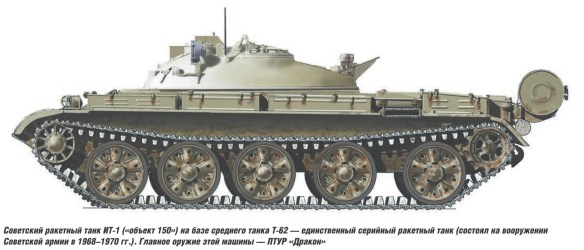The IT-1 Missile (Istrebitel Tankov or Tank Destroyer-1) began life as `Object 150′, born out of necessity and political pressure from Russian government.
Nikita Khrushchev was a big supporter of missile armed tanks and saw the advantage they had over existing AFV’s in Russian service at the time. Testing would run from 1957-1962 with very some good results, as the optics and ammunition of the time limited the accuracy of main battle tanks. The new `3M7 Drakon’ missile excelled over standard ammunition and allowed crews to hit targets further out and with greater accuracy, but with the advent of newer optics and ammunition, the need for missile armed tanks began to wane in favour of standard tanks.
The main drawback of the `Drakon’ missile was the huge 500 metre `dead zone’ around the tank, as in essence the missile would not arm itself until it had passed through a 500 metre zone. This would render the tank useless in a close-range battle. Another problem was the limited number of missiles carried in the tank, merely fifteen rounds, and to complicate things further, the equipment needed for the missile system weighted in at 520kg! Still, even with the drawbacks on the IT-1, the tank managed to serve with the Russian Army for two years, 1968-1970, after which many were converted over to recovery vehicles.
After the Cuban Missile Crisis of 1962, Khrushchev was determined to change the face of world power and American nuclear domination once and for all. He ordered the Oboronka to concentrate on missiles and missile-firing weapons, and was of a mind to eliminate all tanks from the pro duction inventory. The three major tank design bureaus had been given a warning about this in the late 1950s when he requested they examine missile-firing tanks. In 1960, Khrushchev was shown their first efforts: Kartsev’s Object 150, a missile-firing design which used what would become the T-62 chassis and a flat turret, and which eventually was accepted as the IT- 1 tank destroyer; and Kotin’s last new heavy tank design, Object 277, which caused Khrushchev to terminate all heavy tank design work.
This continued to bubble for two years, and at the height of the Cuban problem (22 October 1962) Khrushchev got to see another example of work by the three bureaus. Here Morozov showed Object 430, which he was told to con vert into a missile-firing tank. Kartsev showed Object 167, which carried three 9M14 Malyutka (AT-3 SAGGER) missiles on a rack at the back of its turret; and Kotin showed Object 282, which was a T-10 with a pop-up missile launcher. Khrushchev roundly criticized all three, but only Kartsev stood up to him and argued back that the army still needed tanks. Morozov went back and worked on two antitank missile-armed versions of Object 430, Kartsev did some more on Object 150, but Kotin was told in no uncertain terms that the production of any more heavy tanks would not be tolerated. That the T-10 remained in production until 1966 is a mark of Kotin’s ability to circumvent even the Premier as well as his lack of acumen when it came to future vision.
Top vehicle is Taifun 9M15 (typhoon) was a Soviet missile developed to arm the Obiekt 287 missile tank based on the T-64 tank chassis.
All was essentially reversed when Khrushchev fell from power in 1964, but the grounds had been laid for developing tanks which could also fire missiles through their main guns.
